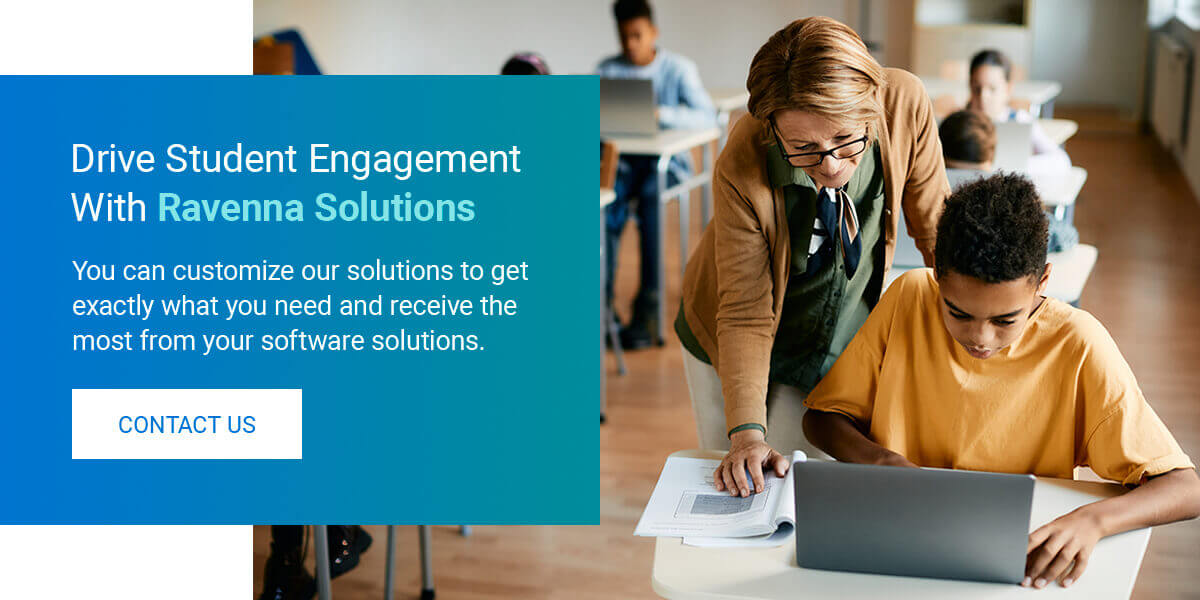School administrators have many essential tasks that help keep their school running and growing yearly. Teachers can help drive student engagement, but so can administrative teams. Your actions can change school culture, show students and families you care, and provide more support for involvement. When determining how to keep students engaged this year, explore our eight tips for implementing strategies for your school.
1. Communicate With the School Community
Availability can help build trust and rapport with students, families, and teachers. When you want to boost student engagement at your school, you must establish two-way communication methods to efficiently receive questions, concerns, and feedback. Email is an ideal way to stay in touch with your school community, especially students. Many schools assign students an email address to reach their teachers and peers for assignments and questions. You can boost engagement by sharing your email address with students and families. When they know how to contact you, they can feel comfortable reaching out with problems and questions that might be beyond their teacher’s abilities. You can also use email to send regular updates and newsletters to families. When emails come from you, families can better see your dedication and investment in the school.
2. Implement the Latest Technology
You can drive student engagement in the classroom by giving them new ways to interact with subjects and lessons. Technology can provide new perspectives and activities for teachers to implement in the school, engaging students in different ways and interesting them more. This teaching method offers several benefits.
- Targeting all learning types: Each student has a preferred learning style, but instructors also have a teaching style. Students might struggle or become disengaged when the teaching and learning styles don’t align. Technology can help deliver the material in a new way that appeals to how the student learns best, keeping them engaged in the content and their education.
- Representing more perspectives: Subjects and concepts require so much context that teachers may struggle to grasp the entirety. Videos and projectors can help connect students with experts who can relay their studies and passion to students. Models and recreations can take students outside the classroom to historical locations and outer space.
- Applying lessons to the real world: Students may disengage from lectures and classes because they fail to see how their learning fits into the real world. Technology can help take material out of the classroom and show real-life examples of their subjects at work.
- Making lessons fun and exciting: Technology can bring games, videos, and stunning videos to the classroom, mixing up routine and bringing the element of fun into learning. Tablets and projectors can offer more interactive lessons, where students can answer questions or participate in class games on their devices. Shifts from traditional education can break up lesson content to keep students engaged throughout the school day.
- Promoting collaboration at all levels: Technology can encourage students to work together. Whether they are playing a game in teams or finishing a group project, devices like projectors, cameras, and tablets make it easier to share and collaborate on work. Students can use email to communicate outside class to connect with friends and plan group projects with classmates.
Different devices and teaching methods vary the way students interact with their teachers, classmates and subjects, encouraging higher levels of engagement inside and outside the classroom.
3. Establish a School Culture and Vision
Your school’s culture will communicate your values to families, teachers, and students. School cultures are significant for private schools, where families and students might look for a specific environment that reflects their wants and needs. Establishing your school’s values through culture can help attract students who are ready to connect with their classes and peers. You can communicate your school’s culture in many ways.
- Visions: A vision or mission statement is a short sentence that highlights what your school believes and strives to do. It is usually broad and general, leaving room for teacher interpretation and student applications. You can use visions to tell families what you value most at your school.
- Goals and objectives: What is your school working toward? Improvement and goals drive student engagement as they progress. You can highlight to your community that you have invested in your students and their growth.
- School offerings: Your school might value specific disciplines or be welcome to all. You can highlight specialized courses that will engage students interested in that subject or your array of clubs, encouraging students to discover new passions.
- Promotions: How you communicate with students and families outside the classroom can impact the relationship they form with your school. Your social media content can demonstrate what you care about — are you posting pictures of students and highlighting their accomplishments? Do you have a newsletter outlining how the month was? What do you focus on during tours? You can boost student engagement by showing you care about it to the community.
When students fit into your school culture, they can better engage in what you can offer. Administrators can practice and enforce school culture and values daily as they interact with members of their school community, making them essential in culture establishment and effectiveness.
4. Promote Extracurricular Activities
Clubs and organizations are excellent ways for students to get involved on your campus and discover their interests. Extracurriculars are also essential to help students apply themselves beyond what your school offers and connect with their peers. Following their passions and skills can boost children’s motivation and confidence and allow them to form lasting friendships. As an administrator, you can encourage students to join and participate in extracurricular activities by highlighting their existence and prioritizing them. When families tour your school, mention some of the clubs you offer. Create a page on your school site dedicated to your organizations and what they do. Announce and advertise club events, like plays, games, and competitions—when students accomplish something, invite the whole school and the surrounding community to celebrate with them. Students will look forward to their after-school activities and give them something to work toward and apply classroom skills to.
5. Get Involved in Student Life and the Community
While promoting your extracurriculars and organizations can highly impact student engagement, you can also show your investment in their lives and success by attending events. Make an effort to be present at every school or club event, from sports games and concerts to competitions and talent shows. When there, talk to the students about their activities. Ask them questions about what they like about the organization or event. Let them tell you what makes this instance inspiring or valuable. Congratulate them on their wins and encourage growth in the face of losses. Showing up shows your school and students that you care about them and their interests beyond learning. You can build relationships and rapport with them that you can use when you encounter students during regular school hours. You can further show your investment in your students by attending community events. Go to fairs, festivals, and shows in your school’s area. You may encounter students and their families at these events, allowing you to interact and get to know students outside the school setting. You can gain insights into their family lives and more of their interests. Additionally, you may learn more about the community and its needs as you interact with people. For example, families and neighbors might express their concern about reading levels, helping you set more goals and objectives for your school. Aligning your interests with the community’s can help direct student and family engagement by tackling problems you both care about.
6. Observe Teachers and Students
Administrative decisions and policies can help drive instructional and classroom changes. If you want to implement new goals and progress toward a specific outcome, you must ensure that all levels can adjust to meet expectations. When teachers drive changes at the student level, administrators can track growth and assist by observing teachers and students. Observe your teachers and students for maximum insight.
- In person: In-person observations are traditional and standard practices. You can sit in classes and evaluate engagement levels in real-time. Your notes can reflect when students might get bored or disengage, helping teachers assess their teaching methods to match student interest and energy flow.
- Recorded: Instead of sitting in on classes, you can ask teachers to record their lessons and students for you to watch later. This method can be less intimidating for students, allowing them to act as they would naturally. Further, you can use recorded segments to demonstrate techniques you want other teachers to implement.
While observation is excellent for noticing student engagement and energy levels, it helps implement a growth mindset at your school. Teachers will see your commitment to optimizing student engagement and will be more motivated to work with you to reach the goal.
7. Support Student Choices
If you want more student involvement in the classroom, giving students a stake in their education and school life can boost engagement. So much of education is up to adults, from required subjects to student schedules. Students can get frustrated when they have little to no say in their studies and progress. Giving students autonomy over their learning and school environment can ease that frustration and encourage them to get more involved in their education. Consider these ways to make students feel heard.
- Learning options: If you want to improve engagement in the classroom, students need a learning environment that meets their needs, interests, and strengths. Giving students a way to customize their learning can help them develop more skills and knowledge in a way that interests them. Encourage teachers to provide choices for assignment types, completion dates, and project partners. With more ownership in their learning, they’ll be more involved and engaged throughout their education.
- School life opinions: You can connect students to their school by giving them more control over what they do there. Some schools let students pick their locker location, field trips, and assemblies from several options. While the administration has the final say, students invest more in school-wide decisions, helping them feel more involved with even the little events.
- Creative opportunities: Students can share their voices and talents through creative opportunities, spreading school spirit and student support. Encourage students to explore creative outlets such as student-led plays, assemblies, and art shows. They will get the chance to share their passions and experiences with the student body, while others can hear from a peer they know and trust.
Student involvement at various levels can do wonders for classroom engagement. Further, you can implement the power of student voice and feedback. Consider gathering random students periodically and asking them for input on specific initiatives or school policies. You can make decisions backed by student needs and wants, helping show you care about their opinion and place at your school. 
8. Use a Student Information System
Having the right tools is essential when improving your school. A student information system is a software solution that tracks student data across school functions, from admissions and enrollment to daily activities like attendance and grade books. When you have many classes and grades to oversee, student information systems can help you manage data to give students the most. Student information systems make accessing data easier for students, families, and teachers. Many systems offer specialized portals for each group, allowing them to view relevant information, from grades to course schedules. When the school community has better access to data, they can focus on their learning and school involvement. These software solutions work well with other systems, helping further manage student data. At Ravenna, our platforms help you manage your student information at several essential points in their journey. Our Automated Workflows solution enables you to boost efficiency by implementing automatic functions into your processes. It sorts applicants based on your unique requirements and will manage your schedule to accommodate appointments and interviews. Ravenna’s Enrollment solution imports and saves student data, simplifying the process for families and reducing redundancy. Families can save time filling in the same information as the solution will transfer and apply it to other stages in the process; returning students can save their data from previous years to optimize enrollment further.

Drive Student Engagement With Ravenna Solutions
Setting goals for your school is only the first step toward improvement. When engaging students as an administrator, software solutions can help manage interactions and build the foundations of your school. At Ravenna, we offer comprehensive platforms designed for private and independent K-12 schools. You can pair solutions to cover every stage of the student journey, from interest and applications to enrollment and financial aid. Ravenna understands that every school is unique. You can customize our solutions to get exactly what you need and receive the most from your software solutions. When you want to boost efficiency, Ravenna Solutions can help you automate more of your manual tasks, and you can refocus your attention on your students. Request a demo today and discover how to maintain student engagement with Ravenna Solutions.



